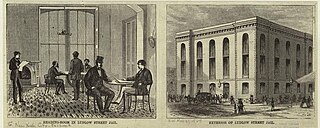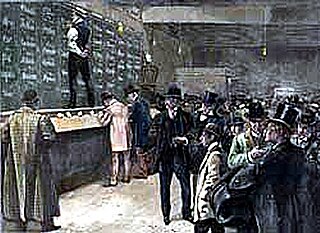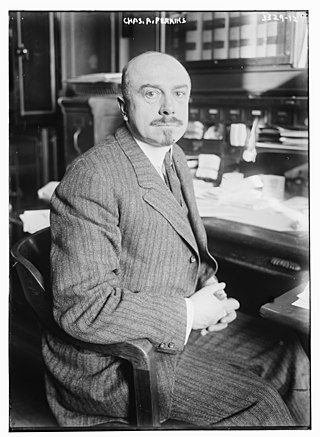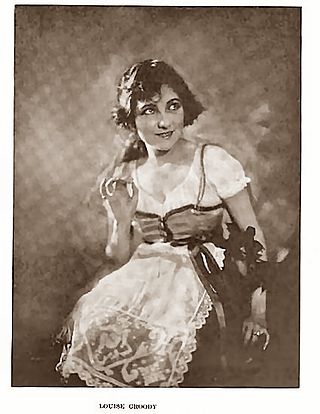Related Research Articles

The Racketeer Influenced and Corrupt Organizations (RICO) Act is a United States federal law that provides for extended criminal penalties and a civil cause of action for acts performed as part of an ongoing criminal organization.

Drexel Burnham Lambert Inc. was an American multinational investment bank that was forced into bankruptcy in 1990 due to its involvement in illegal activities in the junk bond market, driven by senior executive Michael Milken. At its height, it was a Bulge Bracket bank, as the fifth-largest investment bank in the United States.

Richard Whitney was an American financier, president of the New York Stock Exchange from 1930 to 1935. He was later convicted of embezzlement and imprisoned.

The Ludlow Street Jail was New York City's Federal prison, located on Ludlow Street and Broome Street in Manhattan. Some prisoners, such as soldiers, were held there temporarily awaiting extradition to other jurisdictions, but most of the inmates were debtors imprisoned by their creditors. Seward Park Campus now sits on the site of the jail.
William Sylvester Silkworth, referred to in the U.S. press as "W. S. Silkworth", was an American financier known being president of the Consolidated Stock Exchange of New York and being forced to resign because of scandal. starting in 1919. He was also a sport shooter who competed in the 1924 Summer Olympics. In 1924, he won the gold medal as member of the American team in the team clay pigeons competition. Silkworth aggressively and successfully pursued new business for the exchange, and his career as president reached its peak in February 1922, when all trading records at the exchange were broken, ensuring that "Silkworth, not [NYSE president] McCormick, was the talk of Wall Street." Silkworth resigned on June 21, 1923, after an investigation into Consolidated insider corruption discovered irregularities in his personal finances. He later did time for mail fraud. By 1926, Silkworth was best known internationally as a member of the Olympic trap shooting team.

Charles Abraham Stoneham was the owner of the New York Giants baseball team, New York Nationals soccer team, the center of numerous corruption scandals and the instigator of the "Soccer Wars" which destroyed the American Soccer League.

A bucket shop is a business that allows gambling based on the prices of stocks or commodities. A 1906 U.S. Supreme Court ruling defined a bucket shop as "an establishment, nominally for the transaction of a stock exchange business, or business of similar character, but really for the registration of bets, or wagers, usually for small amounts, on the rise or fall of the prices of stocks, grain, oil, etc., there being no transfer or delivery of the stock or commodities nominally dealt in".
Marc Stuart Dreier is an American former lawyer who was sentenced to 20 years in federal prison in 2009 for committing investment fraud using a Ponzi scheme. He is scheduled to be released from FCI Sandstone on June 30, 2025. On May 11, 2009, he pleaded guilty in the United States District Court for the Southern District of New York to eight charges of fraud, which included one count of conspiracy to commit securities fraud and wire fraud, one count of money laundering, one count of securities fraud, and five counts of wire fraud in a scheme to sell more than $950 million in fictitious promissory notes. Civil charges, filed in December 2008 by the U.S. Securities and Exchange Commission, are pending. The 2011 documentary Unraveled states that "Drier stole over $740 million from 4 clients, 4 individuals, and 13 hedge funds".
Joab Hamilton Banton was New York County District Attorney from 1922 to 1929.

Charles Albert Perkins was an American lawyer and reformer who was New York County District Attorney in 1915. While with the District Attorney's office, Perkins prosecuted many of the city's gang leaders, labor racketeers and other underworld figures during the early 20th century. He also served as special prosecutor for several major state investigations into corruption most notably the City Trust cases of 1928–29.

Louise Groody was an American Broadway musical comedy star of the 1920s who introduced to New York audiences the song "Tea for Two" in the musical No, No, Nanette.

The Consolidated Stock Exchange of New York, also known as the New York Consolidated Stock Exchange or Consolidated, was a stock exchange in New York City, New York, in direct competition to the New York Stock Exchange (NYSE) from 1885 to 1926. It was formed from the merger of other smaller exchanges, and was referred to in the industry and press as the "Little Board." By its official formation in 1885, its membership of 2403 was considered the second largest membership of any exchange in the United States.

William J. Fallon christened The Great Mouthpiece by the press was a prominent defense attorney during the 1920s who defended the gangster Arnold Rothstein and his accomplice Nicky Arnstein during the trial for the fixing of the 1919 World Series.
Peter F. McCoy was an American attorney based in New York City. Practicing law in New York at 342 Madison Avenue, McCoy started his legal career with Eaton, Lewis & Rowe before becoming an assistant United States Attorney in 1921. As an assistant United States Attorney General, McCoy was successful at prosecuting high-profile brokers for mail fraud and bucket shops in the early 1920s, with the New York Times proclaiming him a "foe of stock frauds." He also prosecuted people for violating the Food and Drug Acts, selling narcotics, and counterfeiting.
Mortimer Hartwell Wagar was an American banker and businessperson. Wagar was a member of the Consolidated Exchange for 33 years. He was president from 1900 until 1903. He retired from the exchange in June 1923, at which point he was vice president. He also helped organize the Clearing House of the Consolidated Exchange, where he was president.
Edward M. Fuller & Company was a prominent New York stock brokerage. Founded in 1914 and owned by the sole partners William Frank McGee and Edward M. Fuller, by 1922 it was the largest brokerage on the Little Board. The firm went bankrupt in 1922, resulting in a high-profile legal case and indictments against the former partners.
Raynor, Nicholas & Truesdell was a New York brokerage based on Broadway in the 1920s. It was a member of the Consolidated Stock Exchange, before failing on April 29, 1922. The failure resulted in a highly publicized lawsuit over whether the firm committed mail fraud and bucketing before failing.
Watson Bradley Dickerman was an American banker who founded Dominick & Dickerman and served as president of the New York Stock Exchange.

George Rumsey Sheldon was an American banker who served as treasurer of the Republican National Committee.
References
- ↑ "John E. Joyce, 74, Federal Referee – Bankruptcy Specialist for Manhattan and Bronx Dies". The New York Times . November 18, 1963. p. 33. Retrieved May 25, 2017.
- 1 2 3 "Silkworth Resigns From Consolidated and Sells His Seat". The New York Times . June 26, 1923. Retrieved May 25, 2017.
- 1 2 3 "Fuller, Ex-Broker, Shot in Florida – Found With a Wound Believed Self-inflicted in Miami Home He Was About to Lose – Jailed Here With McGee – Served in Sing Sing With Associate for Bucketing That Led to $4,000,000 Failure". The New York Times . October 8, 1932. p. 36. Retrieved May 29, 2017– via Associated Press.
- 1 2 3 "Fuller and McGee Win Sing Sing Paroles; Served Year for $4,000,000 Bucketing Frauds". New York Times. June 1, 1928. p. 1. Retrieved May 25, 2017.
- 1 2 3 4 "Fuller and McGee to Testify Against Former Associates; Convicted Brokers Will Be Released on Bail Today at Hayward's Request". The New York Times . July 18, 1924. Retrieved May 25, 2017.
- 1 2 "Silkworths Sought in Fuller Smash; Process Servers Can't Find President of the Consolidated and His Brother. Creditors Hunt $6,612,000 Fuller's Trial Awaits Decision of U.S. Supreme Court on Right to Use Books". The New York Times . April 26, 1923. p. 21.
- 1 2 3 4 "E.M. Fuller & Co. Fail". The New York Times . June 28, 1922. Retrieved April 18, 2017.
- 1 2 Tosches, Nick (January 1, 2007). "A Jazz Age Autopsy". Vanity Fair .
- 1 2 3 4 5 6 7 Sobel, Robert (2000). AMEX: A History of the American Stock Exchange. p. 30. ISBN 9781893122482.
- 1 2 "Hint Outsiders Got Fuller's Millions – Creditors' Attorney Calls on Federal and County Prosecutors to Investigate – Ex-Manager Surrenders – McHugh Held in $2,500 Bail as Participant in Bucketing Operations – Reveals Cause of Crash – Firm Did Legitimate Business, He is Reported to Have Said, Until Caught in the Market". New York Times. June 28, 1923. p. 5. Retrieved May 29, 2017.
- ↑ "Court Denies Banton Use of Fuller Books; Stipulation Made by Brokers When They Failed Upheld by Judge Hand". The New York Times . August 3, 1922. Retrieved May 29, 2017.
- 1 2 3 4 5 6 "Silkworth, Target of Censure, to Quit the Consolidated – New Exchange Committee May Demand President's Immediate Resignation". The New York Times . June 7, 1923. pp. 1, 2. Retrieved March 4, 2017.
- ↑ "Reports on Fuller to Exchange Lost – Made When Broker Now in Jail Applied for Membership in the Consolidated". New York Times. May 22, 1923. p. 1. Retrieved May 29, 2017.
- ↑ "Fuller to Reveal 'Higher-Ups' Today – Bucket Shop Disclosures Expected if Broker is Well Enough to Leave Jail – Sentence May Be Put Off – President Cromwell of the Stock Exchange Denies Plan to Remove Consolidated Tickers". New York Times. June 18, 1923. p. 1. Retrieved May 29, 2017.
- ↑ "Fuller Won't Name Bucket Ring Heads Without Immunity – Federal Prosecutor Says He Doesn't Feel Justified in Making the Bargain". The New York Times . June 19, 1923. Retrieved May 25, 2017.
- ↑ "Four More Indicted in the Fuller Case – Nature of Charges and Names of Persons Kept Secret by Federal Authorities – Linked with McGee Papers – But Officials Plead Ignorance of Letters Seized From Broker's Ex-Wife on Ship". The New York Times . July 3, 1923. Retrieved May 25, 2017.
- ↑ "Foley Raps Hearst; Cut From Record – Part of His Testimony at Fuller Hearing Stricken Out by Referee Coffin – His Counsel Indignant – Edward E. McCall Threatened With Ejection From Courtroom After Colloquy". New York Times. July 27, 1923. p. 28. Retrieved May 25, 2017.
- ↑ "Fuller Disclosures Called Sensational – Bucketshop Confessions Will Be Made Public Before End of Next Week – New Witnesses Examined – Testimony Said to Have Supplemented Revelations Made by Prisoners – Brokers Fear For Lives – Reports That Gunmen Are on Their Trail Lead Federal Officials to Seclude Them". The New York Times . August 9, 1923. p. 15. Retrieved May 23, 2017.
- ↑ "Stoneham Lawyer Demands Immunity – Leo J. Bondy, Testifying Before Fuller Jury, Refuses to Waive Right". The New York Times . August 28, 1923. Retrieved May 25, 2017.
- ↑ "Jury Bribe Witness Reported Missing; Friends Fear for Safety of Eidlitz, Who Testified in Fuller and Fallon Cases". The New York Times . February 26, 1924. Retrieved May 29, 2017.
- ↑ "Fuller and M'Gee Go To Prison Today – Judge Refuses Appeal for a Further Stay of Sentence Imposed Four Years Ago – Banton Urges Action – Says Brokers Won Immunity in Other Cases – Term in Sing Sing Is From 15 Months to 4 Years". New York Times. June 7, 1927. Retrieved May 25, 2017.
- ↑ "Earned $9.30 In Sing Sing – Fuller and McGee to Draw Year's Pay as They Quit Prison Wednesday". The New York Times . June 4, 1928. Retrieved May 25, 2017.
- ↑ "To Bar Fuller and McGee – Division of Licenses Reported Averse to Them as Realty Brokers". The New York Times . June 18, 1928. Retrieved May 25, 2017.
- ↑ "Rothstein Fights Suit For $366,768 – Receiver Contends Payments by Fuller and McGee Were for Gambling Debts – Holds Them Recoverable – Defendant Argues the Checks Were Cashed as a Favor to the Two Brokers". The New York Times . June 22, 1928. Retrieved May 25, 2017.
- ↑ "Says Rothstein Books Contain No Secrets – Estate Counsel Fights Move of E.M. Fuller & Co. Trustee to Inspect Gambler's Records". The New York Times . October 16, 1929. Retrieved May 25, 2017.